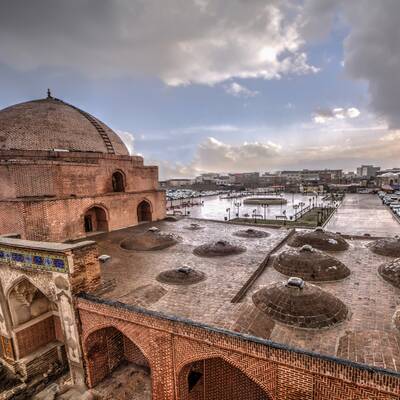
Urmia Museum of Stones and Inscriptions (West Azerbaijan Province)
Located in the district of Se Gonbad (three domes), the Urmia Museum of Stones and Inscriptions has been recognized as the first outdoor museum of stone and inscription in Iran. constructed in-ground with approximately 1800 square meter area, the museum includes the historical three-thousand-year-old rock inscriptions along with a collection of inscriptions in cuneiform. The most important and famous inscriptions located in this museum are related to Urartu civilization. It is the name of a civilization that was formed in the Iron Age.
The geographical area of this civilization spread over the Urmia Lake, Lake Van and the heights of Armenia. They ruled from about 1500 to 600 BC in these areas. Among main Urartu inscriptions discovered that are now kept in this museum the followings must be mentioned: 1- Kale Shin inscription that was discovered near Kale Shin village in the northeast of Iraq, 200km far from the Iran border; it was used as the border column on the path of Roandouz to Oshnavieh which was moved to the museum in order to prevent possible damage during Iran-Iraq imposed war. The name contains two Kurdish names: Kale means the gravestone and Shin means blue. It seems that the name was chosen due to the special type of rock.
The column has two plates on both there are texts written in both Assyrian and Urartu scripts. The first text is concerning the prayer for the godhead and the second describes the war operation. The script was discovered in 1829 by the German Schultz and translated by Minorsky; 2. Eyn ur Rum mountain inscription located on the top of a spring that is called the Dragon inside Qasemlu valley located in the southwest of Urmia, is the only recognized remaining of Urartu along the water in the northwest of Iran. The inscription is located along the Asphalt road of Urmia-Oshnavieh near Aqbolagh village. 3. Mahmoudabad inscription was discovered in 1355 SH in a village with the same name. It is related to Urartu period and belongs to Rosa, the Sardori’s son, one of the famous kings of Urartu.
In the text the ceremony of Sacrifice for god of Shinto, one of the Urartu gods, is described; 4. Movana inscription located on the Tepe of Movana village, in Silvana district, 35km west of Urmia, in a place remained from the first millennium BC. In 1374 SH, an inscription in Assyrian and Urartu cuneiform belonging to Orzana, the king of Mosasir land, was discovered near this tepe.
